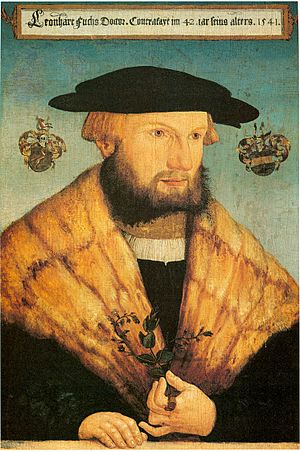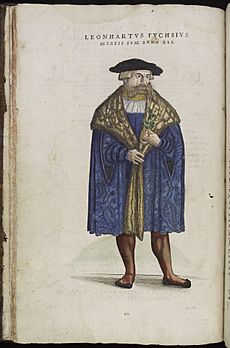Leonhart Fuchs facts for kids
Quick facts for kids
Leonhart Fuchs
|
|
|---|---|

Portrait by Heinrich Füllmaurer, Tübingen, 1541
|
|
| Born | 17 January 1501 Wemding, Duchy of Bavaria, Holy Roman Empire
|
| Died | 10 May 1566 (aged 65) Tübingen, Duchy of Württemberg, Holy Roman Empire
|
| Education |
|
| Scientific career | |
| Fields | Botany |
| Institutions | University of Tübingen |
| Notable students | Johann Bauhin |
Leonhart Fuchs (born January 17, 1501 – died May 10, 1566) was a German doctor and expert on plants. He is most famous for writing a big book about plants and how they could be used as medicines. This book, called a herbal, was first published in 1542 in Latin.
His book had about 500 very accurate and detailed drawings of plants. These drawings were made from woodcuts, which are like stamps carved from wood. The amazing drawings were the best part of his book. While other plant books had drawings, Fuchs's book showed how important high-quality pictures were to truly understand what a plant looked like.
Contents
Leonhart Fuchs's Life Story
Leonhart Fuchs was born in 1501 in a town called Wemding, which was part of the Duchy of Bavaria at the time. He was the youngest child of Johann and Anna Fuchs. His father was the town's mayor, known as a Burgomaster. Both his parents came from important families in the town.
Sadly, his father died in 1506 when Leonhart was only five years old. So, his mother and grandfather raised him. His family thought he was very smart. They felt that the local schools weren't good enough for him.
His Education and Learning
In 1511, when he was ten, Leonhart went to a special grammar school in Heilbronn. The head teacher there, Konrad Költer, also saw how talented Leonhart was. This school was well-known for teaching classical languages like Latin and Greek.
The next year, Fuchs moved to another school in Erfurt, which focused even more on these languages. This was to prepare him for the University of Erfurt. After just six months, he entered the university at age eleven. At that time, Erfurt University was one of the best in Germany. He studied in the Faculty of Arts and earned his first degree, a Baccalaureus artium, in 1516. This degree allowed him to teach.
At 17, he went back to Wemding and opened his own private school. While at Erfurt, he also became good friends with another student, Joachim Camerarius.
In 1519, he started classes at the University of Ingolstadt. There, he learned Latin, Greek, and Hebrew from famous teachers. He also studied some philosophy and botany (the study of plants). He earned his Magister Artium degree in 1521. During this time, he learned about the ideas of Martin Luther and became a follower of the Lutheran faith. He then decided to study medicine and became a doctor in 1524.
His Career as a Doctor and Professor
From 1524 to 1526, Leonhart worked as a doctor in Munich. After that, he was offered a job as a professor of medicine at the University of Ingolstadt. However, this university was very Roman Catholic. They watched their professors closely to make sure their religious beliefs were correct. This caused problems for Fuchs because of his Lutheran views.
So, in 1528, he took a job as the personal doctor to George, Margrave of Brandenburg-Ansbach, who was a Protestant ruler. This job came with the promise of a professorship at a new university the Margrave planned to start. Fuchs stayed in this role until 1531.
In 1533, Ulrich, Duke of Württemberg invited Fuchs to Tübingen. The Duke wanted Fuchs to help improve the University of Tübingen by bringing in new ideas from humanism, which was a way of thinking that focused on human values and achievements.
Fuchs created the university's first medicinal garden in 1535. He also served as the university's chancellor (a high-ranking leader) seven times. He spent the last 31 years of his life as a professor of medicine in Tübingen. He passed away there in 1566.
His Family Life
While working in Munich, Leonhart met and married Anna Catherina Friedberger in 1524. She was the daughter of a city council member. Together, they had 10 children: 4 sons and 6 daughters. Sadly, two of their children died when they were babies.
Leonhart Fuchs's Important Work
While working in Ansbach, Fuchs started writing scientific books. His first important work was Errata recentiorum medicorum (Errors of modern doctors) in 1530. In this book, Fuchs listed 60 "errors" in how doctors practiced medicine at the time. He believed doctors should go back to using the ideas of ancient Greek writers like Dioscorides, Hippocrates, and Galen, rather than relying on Arab medical traditions. He also criticized how medicines were named, which sometimes led to confusion.
This book was liked by some, but it made others very angry. Fuchs defended his ideas in another book called Paradoxorum medicinae (1535), which was a bigger version of his first book.
His Views on Science and Plants
Fuchs, like doctors before him, was greatly influenced by ancient Greek and Roman writers on medicine and materia medica (the study of substances used in medicine). He wanted to move away from the medical practices that came from Arab traditions and return to the original Greek ideas.
Fuchs believed in using simple medicinal plants, known as "simples," instead of the complicated and sometimes harmful mixtures used in medieval times. But he also knew that practical experience was important. He would take his students on trips to the countryside to show them medicinal plants in their natural environment. He also started one of the first botanical gardens in Germany.
Fuchs, along with two other German plant experts, Otto Brunfels and Hieronymus Bock, published important plant books. Their work together led to a "botanical renaissance" (a rebirth of plant study) in Germany in the mid-1500s. Because their work was connected to medicine, it reached many people, both doctors and everyday people.
His Main Publications
Leonhart Fuchs wrote over 50 books and essays. His books about the eye and its diseases were considered standard guides during his time.
Some of his important books include:
- Errata recentiorum medicorum (Errors of modern doctors) (1530)
- Paradoxorum medicinae III (Paradoxes of medicine) (1535)
- Alle Kranckheyt der Augen (All diseases of the eye) (1539)
- De Historia Stirpium commentarii insignes (Notable Commentaries on the History of Plants) (1542)
- Codex Fuchs, Tübingen (1536–1566)
He also helped edit a complete collection of the works of the ancient Greek doctor Galen.
De Historia Stirpium Commentarii Insignes
This book is Fuchs's most important work. It's a large book about plants and their uses as medicines, first published in Latin in 1542. It was quickly translated into other languages.
While much of the text in the book came from earlier writers, its 512 detailed pictures set a new standard for botanical illustration. The accurate drawings, made from woodcuts, were a huge improvement over earlier plant books. Fuchs's book showed how important high-quality drawings were to truly identify a plant. However, it was a very scholarly and expensive book, so it didn't completely replace older, simpler plant books.
Leonhart Fuchs's Legacy
Leonhart Fuchs is remembered in many ways today. His hometown of Wemding is now known as Fuchsienstadt (Fuchsia City). The town uses the color fuchsia as its theme and has many Fuchsia plants in public places.
The house where he was born has a special plaque. It's known as the Zwergenhäuschen (dwarf house) because it's so small. The plaque says: 1501 – 1566. Leonhart Fuchs, a famous doctor and botanist, was born here. The fuchsia was named after him.
In 2001, for the 500th anniversary of his birth, a special glass and steel building called the Fuchsienpavillon (Fuchsia house) was opened in the Botanischer Garten der Universität Tübingen. This building holds a collection of fuchsia plants.
There's even a type of Fuchsia plant named 'Wemding'. Every year, Wemding has a "fuchsia tour" and creates a fuchsia pyramid. There's also a "fuchsia and herb market," and some local businesses and a school are named after Fuchs.
Fuchs, along with his older German colleagues Otto Brunfels and Hieronymus Bock, is often called a "father of botany." They helped make botany a scientific field separate from medicine in the 1500s.
After he died, the original handwritten book and the plates (the woodcuts used for printing) of his Historia were kept in the Austrian National Library in Vienna, where they still are today.
How His Name Lives On
Fuchs's name is kept alive by the beautiful plant called Fuchsia. This plant was first found in the Caribbean in 1696 by a French scientist named Charles Plumier. He described the plant in 1703 and named it after Leonhart Fuchs.
The color fuchsia is named after the flower. The dye called fuchsine (also known as magenta) was developed in 1859. It was named fuchsine because its color was similar to the flowers of some Fuchsia species. Also, the French word Renard (the name of the dye's original maker) and the German word Fuchs both mean "fox."
Fuchs's name is also used in the scientific name of a common orchid found across Europe and Asia: Dactylorhiza fuchsii.
See also
 In Spanish: Leonhart Fuchs para niños
In Spanish: Leonhart Fuchs para niños
- Learned medicine
- Medical Renaissance
- History of herbalism
- Lactofuchsin mount
Images for kids





